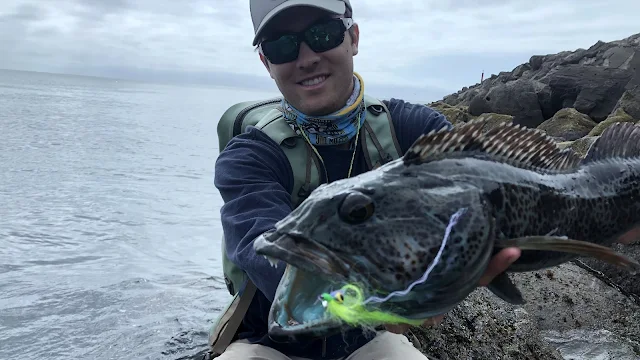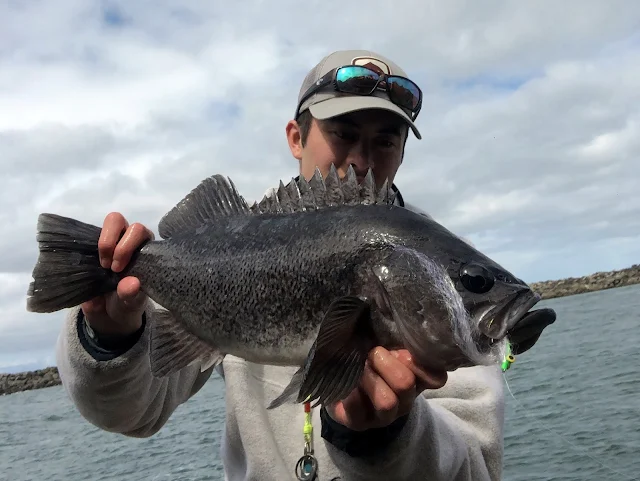Got plans to head to the coast this spring? Well, I’d bring some fly rods with you and I’ll tell you why:
Spring can be an interesting time of year regarding fishing. Winter steelhead fisheries are closed or slowing down as fish are either spawning or returning back to the salt. Hardcore steelhead anglers might be getting ready to hang the waders up for a few months until the first summers start arriving, while other anglers, are getting ready for trout season to open. This past spring, I geared up the full sinking lines, clousers, and single hand 9 weights and headed to the coast in pursuit of a different species on the fly.
Jetty fishing on the Oregon Coast has always had a special place in my heart. Growing up, jetty fishing was one of the first kinds of fishing that my dad introduced me to. I can remember early mornings hiking out over the large slippery rocks in pursuit black rockfish, kelp greenling, rock perch, cabezon, and the prized lingcod.
Fly fishing off the rocks is a fishery that is beginning to gain some traction and a bit of press, although almost every time I go out there with my fly rods in hand, I am outnumbered by gear fisherman and usually get many confused looks from other anglers as I stand perched out on the rocks, throwing double hauls with an eight inch fly. To each their own.
The Gear
This type of fishing requires a stout rod. I like a saltwater 8 or 9 weight single hand fly rod but there have been some instances out there where I wished I had my 10 weight. Freshwater or all purpose 8 weights generally have too light of a butt section for these strong fish. Saltwater specific 8 weights like the Sage Maverick or Sage Payload: Sage Maverick and Sage Payload, are a bit beefier and can handle the large flies, heavy lines, and large fish you’ll hook into out on the rocks. You don’t need to get too crazy with reels. Something that matches the rod you’re throwing and can hold 100 yards of backing plus your fly line is suitable. I personally have been using a Redington Behemoth in the ⅞ size. Redington Behemoth. Most important thing is to make sure the reel has a sealed drag to prevent salt from getting into the drag and causing corrosion.
 |
| Rockfish |
The line system is probably the most important part to this kind of fishing. Your standard weight forward floating line, even if it is designed for saltwater, will not cut it (at least by itself). Most of these jetties on the Oregon Coast drop off pretty quickly and you’re fishing in water that is 15-25 feet deep and sometimes fighting tidal currents as well. You need to get down right away. I run a 250 grain line from Cortland, (it’s an old line but gets the job done) which has a 30 foot sinking head that integrates into a floating running line. Before using this line, I was running a RIO Big Nasty fly line with a 12 foot section of T-20 sink tip on the end, which was difficult to cast, but it got me to the right depth as it equates to a similar overall grain weight as the Cortland line. The RIO Leviathan line would be a great choice as well. RIO Leviathan Line., as would the Airflo depth finder.
I then run about 2 or 3 feet of RIO saltwater tippet in the 20-30 pound range. These fish are not leader shy so you don’t need to worry about running fluorocarbon. I also tend to use a pretty short section of this tied with a perfection loop to the end of my fly line. The shorter this section is, the more it will stay down on the bottom and lingcod don’t care if your fly is relatively close to your fly line, they are going to crush the fly regardless.
 |
| Clouser Minnows |
Speaking of flies, this is where the fun starts. I tie my own clousers and the color combos that I’ve had the most success on are chartreuse and white, black and white, all white and all black. I tie them on with a Gamakatsu SL 15 3/0 hook, using the XL yellow or red dumbbell eyes, chartreuse thread, and bucktail as the main body. Throwing a little crystal flash in never hurts either. I tie them about 7-8 inches long and have found that the black rockfish like that huge size just as much as the lings do.
When to go and presentation
Spring is by far my favorite time to climb out on the rocks and pursue these fish. March-May is the time of year that many lingcod move inshore from the deep water to spawn. Females deposit a cluster of eggs and the males fertilize and guard these eggs as if their life depended on it and will voraciously attack anything that comes near. There are some resident lings that hang around these inshore jetties year round, but in the early spring, many large females and large males move in close, making them accessible to fly anglers.
The presentation you’re looking to achieve is simple. I generally throw about a 30 foot cast and count 10 seconds to let it sink, then just strip my fly in, varying speed from slow to fast. You’ll hook both black rockfish, lingcod and the occasional cabezon doing this. Be prepared to lose some flies. Ideally you want your fly dancing right above the rocks on the bottom of the jetty. The closer you get the more lings you’ll hook, but also the more flies you will lose. Hooking them is the easy part, keeping them up and out of the rocks is the difficult part. This is where having a stout rod comes in handy to force them out of the rocks where they instinctively will go when hooked.
Tides and general ocean swell are another important factor to this fishery. People have their own opinions on the tide but I’ve personally done best on an outgoing tide and into the low tide. This is because I can get down closer to the water, and many of the large rocks are exposed now, making your odds of snagging on them go down. I’ve caught them in high tides though as well, so you can’t be picky, just gotta GO. In between tides can be tough as their can be heavy current making it tough to get a presentation in there. Slack tides are the best.
Check swells before going. It can be very dangerous out there if you go on a rough day as waves can easily crash over the entire jetty. I use magic seaweed to check swell reports and usually only will go if the swell is reported to be below 5 feet. 1-2 foot is ideal. The limit is 7 black rockfish and 2 lingcod per day per angler, with a minimum length of 22 inches for the lings.
This is an exciting fishery where quantity is the name of the game. These fish pull hard and will test you as an angler and make you a better one at that. Of course, don’t be afraid to call the shop for questions. Believe me, it is a hell of a lot of fun coming right out of winter steelhead season, where you can hook many fish in any given day and fill the freezer for months to come.
--Zach Parker
"The Gorge"
Gorge Fly Shop Team - 541.386.6977


























No comments :
Post a Comment